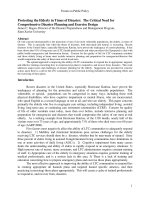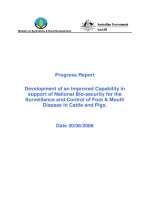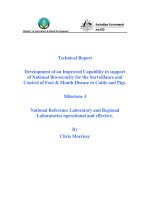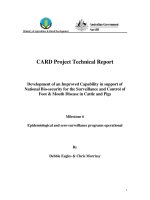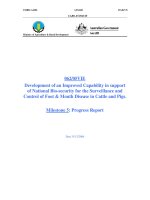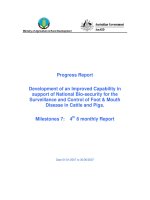MacroEconomics in times of liquidity crises searching for economic essentials
Bạn đang xem bản rút gọn của tài liệu. Xem và tải ngay bản đầy đủ của tài liệu tại đây (2.15 MB, 265 trang )
www.ebook3000.com
Macroeconomics in Times of Liquidity Crises
www.ebook3000.com
The Ohlin Lectures
Protectionism Jagdish Bhagwati
Economic Stabilization and Debt in Developing Countries
Richard N. Cooper
Unemployment and Macroeconomics Assar Lindbeck
Political Economy of Policy Reform in Developing Countries
Anne O. Krueger
Factor Proportions, Trade, and Growth Ronald Findlay
Development, Geography, and Economic Theory Paul Krugman
Unintended Consequences: The Impact of Factor Endowments,
Culture, and Politics on Long-Run Economic Performance
Deepak Lal
Globalization and the Theory of Input Trade Ronald W. Jones
Too Sensational: On the Choice of Exchange Rate Regimes
W. Max Corden
Globalization and the Poor Periphery before 1950 Jeffrey G.
Williamson
The Development and Testing of Heckscher-Ohlin Trade Models:
A Review Robert E. Baldwin
Offshoring in the Global Economy: Microeconomic Structure and
Macroeconomic Implications Robert C. Feenstra
Trade Policy Disaster: Lessons from the 1930s Douglas A.
Irwin
The Craft of Economics: Lessons from the Heckscher-Ohlin
Framework Edward E. Leamer
Macroeconomics in Times of Liquidity Crises: Searching for
Economic Essentials Guillermo Calvo
See for a complete list of titles in
this series.
Macroeconomics in Times of Liquidity Crises
Searching for Economic Essentials
Guillermo Calvo
The MIT Press
Cambridge, Massachusetts
London, England
www.ebook3000.com
© 2016 Massachusetts Institute of Technology
All rights reserved. No part of this book may be reproduced in any form by
any electronic or mechanical means (including photocopying, recording, or
information storage and retrieval) without permission in writing from the
publisher.
This book was set in Palation by Toppan Best-set Premedia Limited. Printed
and bound in the United States of America.
Library of Congress Cataloging-in-Publication Data
Names: Calvo, Guillermo A., author.
Title: Macroeconomics in times of liquidity crises : searching for economic
essentials / Guillermo A. Calvo.
Description: Cambridge, MA : MIT Press, 2016. | Series: The Ohlin
lectures | Includes bibliographical references and index.
Identifiers: LCCN 2016016503 | ISBN 9780262035415 (hardcover : alk.
paper)
Subjects: LCSH: Liquidity (Economics) | Financial crises. | Money. |
Macroeconomics.
Classification: LCC HG178 .C35 2016 | DDC 339--dc23 LC record
available at />10 9 8 7 6 5 4 3 2 1
In grateful memory of Professor Julio H. G. Olivera,
who motivated and inspired generations of Argentine
economists
www.ebook3000.com
Contents
Preface ix
Introduction
xv
I
Toward the Liquidity Approach 1
1
Financial Crises and the Slow Mutation of
Conventional Wisdom 3
2
The Liquidity Approach to Financial Crises 23
3
Monetary Theory: Overview and Liquidity
Extensions 51
4
Nominal Anchoring with Liquid Monetary
Policy Assets 75
5
Liquidity Crunch/Trap: Some Unconventional
Output/Employment/Growth Implications 85
www.ebook3000.com
viii
II
Contents
Emerging Market Crises through the Lens of the
Liquidity Approach 109
Introduction to Part II 111
6
Systemic Sudden Stops:
Crises and Recoveries in EMs 117
Guillermo Calvo and Pablo Ottonello
7
Systemic Sudden Stops:
The Relevance of Balance-Sheet Effects and
Financial Integration 143
Guillermo Calvo, Alejandro Izquierdo, and
Luis-Fernando Mejía
Appendix Tables 173
Technical Appendix: Inference with Random-Effects Probits
under Endogeneity 195
Walter Sosa Escudero
Notes 201
References 217
Index 233
Preface
When I got the email from Mats Lundahl on December 2011
inviting me to give the Ohlin lectures, I was elated. The
Heckscher–Ohlin–Samuelson theorem was one of my first
encounters with economics. It left an indelible mark on my
mind and set the roots for a long-lasting love for economics.
The theorem has three features that appealed to me: simplicity, potential relevance, and beauty. A few minutes after
reading the email, though, elation gave rise to a creepy
feeling of inadequacy. I have spent most of my career working
on macroeconomics. International trade was not absent from
my catalog, but there was hardly anything that I could
readily offer, and that I would consider fitting for honoring
the memory of someone who had made seminal contributions to the field. I shared my trepidations with Mats and my
dear friend Ron Findlay, who quickly, but gently, disabused
me of my wrong priors. Actually, Professor Ohlin’s wings
have covered a wide spectrum of other issues, among which
there exists a large number of newspaper columns on the
Great Depression written in Swedish while the crisis was
taking place (which, fortunately, are summarized in Carlson
and Jonung 2002). Thus, all of a sudden, clouds parted, and
contact with the great man was established. I immediately
replied to Mats with a resounding “yes”!
www.ebook3000.com
x
Preface
Visiting the Stockholm School of Economics was a treat.
Mats officiated as an accomplished chaperone. My wife Sara
and I enjoyed every minute of it, and we had the privilege
of meeting some of Professor Ohlin’s family. As we were
leaving the Stockholm’s airport, I felt inspired and ready to
start writing this book, but it did not take long for me to
realize that there was a long distance between the lectures
and the keyboard. In the lectures I was able to combine experience, intuition, and a little bit of theory—and convey my
view about the recent financial crises, putting special emphasis on emerging market economies, which had first exposed
me to the mysterious ways in which these crises evolve. I
realized afterward that the glue that helped me to feel comfortable about these various issues contained a large dosage
of emotion—not a sentiment that is highly regarded by my
peers! Thus my first attempts at writing this book resulted,
not in a cohesive oeuvre, but in a series of essays full of
duplication and little “soul.” Besides, while I was struggling
to find the right approach for the book, a torrent of books and
papers started to circulate, not to speak of the torrent of relevant factual information that was filtering in nonstop every
day! Keeping up with the literature and events militated
against finding the soul of the book. “Soul,” as is well known,
can only be found by introspection.
It eventually dawned on me that I had to “swim or sink,”
and that perhaps the best way to serve the reader was to offer
a coherent view that abstracted from many details, important
as they were, and concentrated on “essentials.” This is captured in the book’s subtitle. Then again, the title highlights
two interrelated themes in the book: (1) liquidity crises and
(2) the resulting crisis of macroeconomics. This focus, incidentally, gave further relevance to the search for essentials.
Facing a debacle it is wise to take a look at the big picture,
Preface
xi
trees can wait!1 Admittedly, however, the picture examined
in the book, although large for economics standards, is
confined to issues that arise mostly in economists’ circles.
There is no effort made to bring to the discussion insights
from other disciplines like psychology, anthropology, or
history. These insights are important, but the book argues
that substantial progress can be made by expanding the
focus of traditional macro models to account for liquidity
considerations.
The first task in writing the book was to find a center of
gravity: one or two concepts that help give coherence to
the conceptual discussion, and around which the rest of the
book’s universe rotate. In this respect I try to convince the
reader that “liquidity” and “liquidity crunch” are phenomena around which many of the other facets of crisis episodes
rotate. Relatedly, I resuscitate a fundamental idea hidden
in Keynes’s General Theory that has gone unnoticed in
mainstream macroeconomics (and Keynes himself does not
seem to have done much with it), namely that the resilience
of currencies like the US dollar may have a lot to do with
these currencies’ role as worldwide units of account and,
more important, to the prevalence of nominal rigidities.
Conventional theory portrays nominal rigidities as the bane
for full employment. However, Keynes’s conjecture, which I
label “The Price Theory of Money,” suggests that nominal
rigidities are the rock on which paper monies anchor
their flimsy feet on real output. This helps rationalize the
incredible resilience of the US dollar, for instance, while
other dollar-denominated assets that, in principle, should
enjoy a stronger output backing suffered a devastating
liquidity crunch. These ideas lie at the core of the book or,
perhaps, I should say at its “soul.” The rest of the book
elaborates on the limbs that connect the soul with stylized
www.ebook3000.com
xii
Preface
facts associated with financial crises—both in emerging and
developed economies—and with conventional and recent
macro theory.2
Another reason for highlighting “liquidity” factors is that
major recent financial crises are systemic, in the sense that
they occur simultaneously in a variety of different economies. Idiosyncratic factors are no doubt important, but
given the ubiquity of systemic crises, the first step should be
to identify phenomena that can hit economies displaying
widely different “fundamentals” at about the same time.3
Thinking long and hard about this issue led me to zero in on
the payments system for which liquid assets are of essence.
Individual economies’ vulnerabilities are not enough to
rationalize systemic crises. This is important to keep in mind
because the simultaneity of financial crises is not a popular
topic in current theory. This worries me because ignoring
systemic crises may drive us to focus on old “fundamentals,”
such as productivity shocks, in which the global payments
system plays no significant role.
The audience that I have in mind for the book are individuals who are already familiar with the large popular
literature summarizing the many details of financial crises,
but have reached a point where the need for substance overtakes the thrill of anecdote—and are interested in getting a
more in-depth or, if you will, essential view of these issues.
Chapters 1, 2, and 6, and the introduction to part II offer this
in plain English. The discussion in the rest of the book is
more aimed at my peers—and hence requires some training
in economics. However, most of the chapters are spiced up
with enough comments that should help the reader grasp the
main intuitions without having to work through formal
derivations.
The book puts global liquidity shocks at center stage, but
it does not offer a framework that helps “predict” the next
Preface
xiii
crisis—for example, it does not attempt to push the frontier
of “leading indicators.” As a first approximation, global
shocks are taken as exogenous. Instead, the book will elaborate on (1) facts that show the importance of liquidity shocks,
(2) resilience of some liquid assets to liquidity shocks, (3) the
limits of standard monetary policy during a liquidity crisis,
and (4) domestic factors that may exacerbate the depth of
global liquidity shocks on output and the labor market, and
the speed of recovery. The book therefore does not attempt
to offer a new “General Theory” but rather highlights some
factors and mechanisms that are useful and occasionally
insightful in understanding the whole picture. Neither does
the book attempt to give a survey of the financial crisis literature, so I must apologize for the lack of a comprehensive
relevant bibliography. The book is based on my Ohlin lectures in which the objective was to offer a unified, but simple,
view of financial crises, with special emphasis in emerging
market economies.
There is something that I should like to make very clear.
I strained to make the book highly readable and to keep the
technicalities as simple as possible. But my own personal
motivation is to search for “economic essentials.” Essentials
modern economics tends to disregard and privilege instead
extensions of mainstream models. I hasten to say that I would
be the last one not to appreciate sophisticated models.
However, I am afraid that some of my peers will tend to take
a discussion of some of the “essentials” discussed in this
book as an attempt to inform the layman or the undergraduate student, but having scant value for them. I beg to disagree. In fact I think the liquidity discussion in the book has
some novel insights for the modern economist (although I
am less sure these insights would be considered novel by the
likes of Keynes, Fischer, or Minsky!) that could help solidify
www.ebook3000.com
xiv
Preface
the foundations of macroeconomic analysis, particularly in
regard to financial crises. Hopefully, then, if my somewhat
immodest claims contain some truth, the book could also
serve as inspiration for the architects and designers in the
profession, especially those prepared to think “out of the
box.”
In writing a book of this nature, one tends to incur many
debts, and the present instance is no exemption. I will not
attempt to list the names of all to whom I am highly indebted
because the list will be a “who’s who,” and I am likely to
leave out names that I will later regret. So I will mention,
without implicating, the names of just a few with whom
I have spent many hours and days puzzling over the
issues raised in this book: Fabrizio Coricelli, Alejandro Izquierdo, Enrique Mendoza, Pablo Ottonello, Carmen Reinhart,
Ernesto Talvi, Carlos Végh, and Andrés Velasco. Last, but not
least, I would like to thank Sara Calvo for her selfless support
and penetrating comments and insights—constantly and
during many years.
The book has also greatly benefited by constructive (and
occasionally acrimonious) comments from several anonymous referees, as well as MIT’s editorial help and encouragement during a long journey. I am especially indebted to Jane
Macdonald, Acquisitions Editor at MIT Press.
Introduction
As the ravages of the subprime crisis that started in
2007 and became fully evident in 2008 are sinking into the
collective conscience, the self-assertiveness that dominated
the developed market economies (DMs) is fading away,
and giving rise to a nagging sense of insecurity. Prior to
2007, financial crisis episodes in emerging market economies (EMs) had already shown that both saints and sinners
could be casualties. The Asian Tigers, the paragon of good
macro policy, suffered major setbacks in 1997, a crisis that
was followed by an even more disconcerting one: the
Russian 1998 crisis, which spread its wings all across the
EM landscape. Nonetheless, these episodes were discounted
by DMs under the presupposition that their economies
had much stronger financial institutions and the fact that
they had enjoyed a high degree of macroeconomic stability
since the 1980s (which included a period called the Great
Moderation).
That was then. The subprime crisis that started in 2007 has
changed economists’ views in a radical way. There is now no
major disagreement that a key source of trouble in the current
episode is the financial sector’s dysfunctionality, possibly
induced by populist policies and institutions such as Fannie
www.ebook3000.com
xvi
Introduction
Mae (e.g., see Calomiris 2009). As the narrative goes, financial excesses were eventually revealed by problems in the
subprime mortgages’ market, which gave rise to a massive
liquidity crisis and a flight to quality—the latter taking the
form of excess demand for “hard currencies” (also called safe
currencies in this book), a phenomenon that is usually labeled
liquidity trap.1 These concepts are only now being subject to
rigorous analysis.
Interestingly, however, liquidity crunch and liquidity trap
are, in principle, mutually incompatible phenomena, a fact
that seems to have escaped economists’ attention. Liquidity
crunch takes place because the market fears that some key
liquid financial assets (e.g., asset-backed securities, ABS)
will become less acceptable as Means of Exchange (MOE)
or credit collateral. Liquidity trap is a situation in which
the public reveals an insatiable appetite for, typically, some
safe fiat money (e.g., US dollar or yen). The puzzle is
that fiat monies are assumed in the literature to have a
weaker output backup than, say, ABS. Thus the question
arises, why would investors fly away from ABS and into
US dollar, for example? This basic question calls for an
answer.
Fortunately, Keynes’s General Theory has an answer that,
curiously, appears to have been totally overlooked by the
profession. The answer could be paraphrased in Clintonesque lingo as: It is sticky wages/prices, stupid! According to
this view, which I will label the Price Theory of Money
(PTM), fiat money is backed up in real terms by the inflexibility of prices and wages (accompanied by some flexibility in
the supply of output and labor services at given prices).2
Under these circumstances, wage earners and firms become,
in a fashion, the lenders of last resort for fiat money. This
feature gives to money a stable output backup not available
Introduction
xvii
for most other financial assets (except bank deposits and
other assets ensured by the corresponding central bank or
lender of last resort), and it helps explain why a run on
financial assets could be consistent with liquidity trap—and
why, under normal conditions, monetary economies in a
multi-monies world are more stable than the existence of
flimsy fiat monies would lead us to believe. As I will argue,
the PTM offers some solid ground to justify the relative resiliency of the output value of money and the pyramid of
financial assets that are denominated in terms of money
(especially bonds). The PTM rationalization for the value
of money is radically different from standard explanations
based on regulations like legal tender and the obligation to
pay taxes with domestic money instruments. The mechanism
behind the PTM could conceivably be spontaneously generated by the private sector and have ramification that go far
beyond the confines of individual countries (as is the case of
reserve currencies, i.e., currencies that are employed in international transactions). It is therefore a theory that is especially adept to addressing global liquidity issues encountered
in systemic financial crises.
The book will be centered on the assumption that liquidity crunch is the main triggering factor behind financial
crises. The reason for taking liquidity crunch as a largely
exogenous shock is that there is a well-established microeconomic literature showing that “liquidity” is a fragile
object subject to “runs,” and that the latter may result in the
economy permanently shifting to another equilibrium (see
the seminal paper by Diamond and Dybvig 1983). The
Diamond–Dybvig approach to liquidity runs helps rationalize the fact that major financial crises have an important
“surprise” component expressed in the unusually large size
and the hard to predict timing of these crises. Moreover
www.ebook3000.com
xviii
Introduction
this approach comes with an important bonus: it greatly
simplifies the discussion and hence offers a reliable “first
approximation.”3
A sharp focus on liquidity allows highlighting some characteristics of liquid assets that are easy to miss otherwise. For
example, as I argue in the book, the set of liquid assets may
depend on the central bank’s interest rate. Thus low interest
rates on US Treasury bills may give incentives for enhancing
the liquidity of less safe assets that exhibit more attractive
rates of return. Another example is a capital inflow episode
in which liquidity is enhanced by the higher turnover rate of
the associated assets.
Financial crises would not be of major concern from a
social welfare point of view if it just hit rich bankers. Unfortunately, that is not the case. Often “Main Street” is swept
away by “Wall Street” miscalculations. I will argue that
liquidity crunch has a direct effect on credit flows and results
in ex post overindebtedness because intertemporal transactions strongly depend on the expected liquidity of credit
collaterals. Moreover, as a rule, shocks to the credit channel
are painful for Main Street because they prompt a search for
a new equilibrium output configuration, a time-consuming
process.
I highlight in part I the role of liquidity and the many
relevant issues that are consistent with views in which liquidity takes center stage. I present in chapter 1 a summary of
stylized facts (i.e., empirical essentials) on the recent EM
financial crises and the subprime crisis, especially those facts
that unroll puzzles for conventional theory. In chapter 2,
I summarize the main components of a view centered on
liquidity, which I label the liquidity approach. In chapter
3, I outline the established monetary theory and discuss
Introduction
xix
extensions aimed at accounting for relevant liquidity shocks.
My central claim is that simple extensions of standard monetary models—which, as a rule, ignore financial complications—help rationalize the implications of liquidity crunch.
One lesson is that a liquidity crunch provokes changes in
relative prices (e.g., collapse in real estate prices) that cannot
be undone by conventional monetary policy, not even quantitative easing. Another lesson is that liquidity crunch and
inflation have diametrically opposite effects, depending on
whether these phenomena have an impact on consumers or
firms—an issue that harks back to the Ohlin–Keynes debate
about Keynes’s theory of interest (see Davidson 1965; Tsiang
1980).
The extensions above rely on the assumption that liquidity shocks are exogenous, an assumption shared by the
new crop of macro models. A distinguishing characteristic
of the models in chapter 3 is that results call for minor
variations on the conventional representative-individual
rational expectations model. This may seem like an oversimplification, but it is in line with the search for “essentials,” for these models could be greatly enriched and still
core results stemming from liquidity considerations would
stay invariant. In fact the chapter illustrates the possibility
that richer microfoundations can have misleading policy
implications.4
In chapters 4 and 5, I discuss slightly more technical
models that highlight liquidity issues. I show in chapter
4 that if government debt instruments are endowed with
liquidity (an approach originally put forward in a rationalexpectations macroeconomic model in Calvo and Végh
1995), some familiar propositions of mainstream monetary
theory do not hold, even though all other aspects of the
www.ebook3000.com
xx
Introduction
model follow conventional lines. In particular, under sticky
prices the central bank would be able to target inflation
even though it does not follow Taylor’s rule. This result
may serve as a warning to central bank technicians that
liquidity considerations could substantially change the
policy implications of their favorite models. In chapter 5,
I show that by fitting standard monetary models with
assumptions by which consumers’ means of exchange is
cash while those of firms are cash and asset-backed securities, one can rationalize the simultaneous occurrences of
liquidity crunch and liquidity trap, though the two phenomena, as stated above, look contradictory. I also show that the
model offers a straightforward rationale for secular stagnation if the liquidity shock is not offset by the creation of other
liquid assets.5
I present in part II of the book an empirical exploration of
the effects, and not the causes, of liquidity crunch. I do this
in an indirect way by studying Systemic Sudden Stops (of
capital inflows), under the presumption that the latter are
largely triggered by liquidity crunch–type phenomena. I give
in chapter 6 an overview of the salient characteristics of Systemic Sudden Stop crises and show that they are different in
interesting ways from regular recessions. In particular, I
show that in Systemic Sudden Stop, output rebound does not
require a recovery of all the pre-crisis sources of credit, even
though credit crunch is a central trigger for these episodes.
Following Calvo et al. (2006), I call this phenomenon the
phoenix miracle, in reference to the bird rising from its ashes.
I also show that Systemic Sudden Stop crises are associated
with less consumption smoothing and more persistent effects
than regular recession episodes.
Introduction
xxi
I attempt in chapter 7 to identify the determinants of
Sudden Stops (of capital inflows)—a type of credit crunch,
very common in EM financial crises—conditional on the existence of systemic stringent financial conditions in EMs. The
results suggest a strong probability of a Sudden Stop occurring if there is a hike in the EM average risk premium or US
interest rates and net international reserves are low.
www.ebook3000.com
I
Toward the Liquidity Approach
www.ebook3000.com
